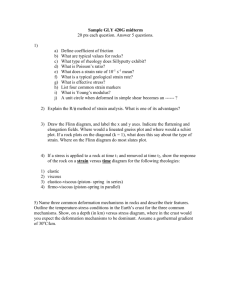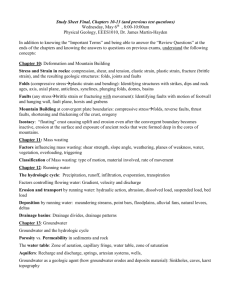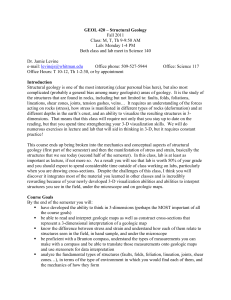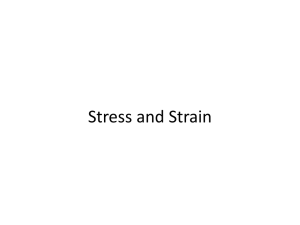Midterm review
advertisement
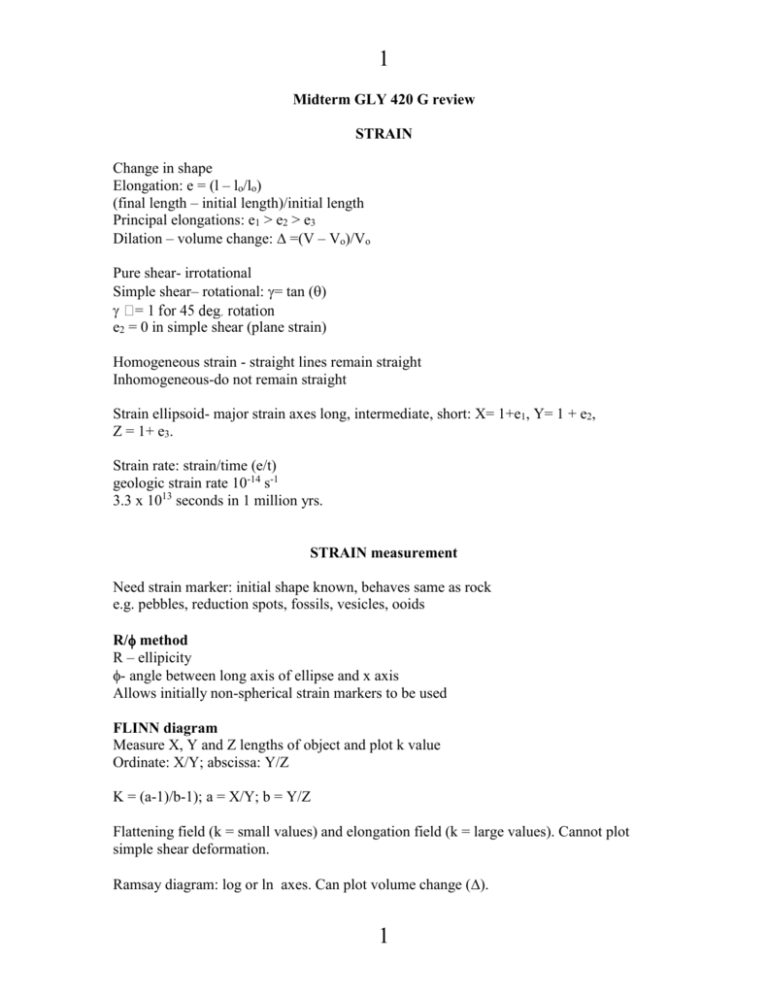
1 Midterm GLY 420 G review STRAIN Change in shape Elongation: e = (l – lo/lo) (final length – initial length)/initial length Principal elongations: e1 > e2 > e3 Dilation – volume change: =(V – Vo)/Vo Pure shear- irrotational Simple shear– rotational: = tan () e2 = 0 in simple shear (plane strain) Homogeneous strain - straight lines remain straight Inhomogeneous-do not remain straight Strain ellipsoid- major strain axes long, intermediate, short: X= 1+e1, Y= 1 + e2, Z = 1+ e3. Strain rate: strain/time (e/t) geologic strain rate 10-14 s-1 3.3 x 1013 seconds in 1 million yrs. STRAIN measurement Need strain marker: initial shape known, behaves same as rock e.g. pebbles, reduction spots, fossils, vesicles, ooids R/ method R – ellipicity - angle between long axis of ellipse and x axis Allows initially non-spherical strain markers to be used FLINN diagram Measure X, Y and Z lengths of object and plot k value Ordinate: X/Y; abscissa: Y/Z K = (a-1)/b-1); a = X/Y; b = Y/Z Flattening field (k = small values) and elongation field (k = large values). Cannot plot simple shear deformation. Ramsay diagram: log or ln axes. Can plot volume change (). 1 2 STRESS Stress = force/area Dimensions = ML/L2T2 Units : Pascals; kilobars; 100 Mpa = 1 kilobar Pascal = Newton/m2 Vector components: normal stress (n) and shear stress ( s) 3 Principal stress directions: , 2, 3 no shear stress across plane normal to principal stress Stress at depth = density x gravity x depth (gh) 1 =2 = 3 Single point on Mohr diagram Lithostatic stress: due to weight overlying rock stress at 1 km depth: 2700 kg/m3 x 9.8 m/s2 x 1000 m = 2700. 9.8. 1000 = 26.4 x 106 Pa = 26.4 MPa = 0.264 kbars Mean stress : (1+ 3)/2 Differential or deviatoric stress: (1- 3)/2 related to rock strength. Effective stress: (n – Pfluid). Pluid pressure weakens rock. Promotes tensile fractures. Anderson theory of faulting Assumes one principal stress is vertical near earth surface. Normal faults: sigma max. vertical; sigma min. horizontal Thrust faults: sigma max horizontal, sigma min. vertical Strike slip: sigma intermed. vertical Mohr circle Center of circle = mean stress Radius of circle = differential stress Positive shear stress = left lateral Negative shear stress = right lateral Positive x direction = compression Negative x axis = tension 2 3 Plane makes angle with normal to sigma one (1) What is the Mohr circle good for? 1) Predicts rock failure with Coulomb line: ( = c + n) 2) Predicts effect of fluid pressure (circle moves left) 3) Predicts angle of fault to normal to max. stress (2) 4) Distinguishes shear fractures versus tensional fractures. 5) Predicts fault re-activation or new fault will form. RHEOLOGY Elastic- stress proportional to strain-recoverable Hooke’s law: (E: Young’s modulus; units Pa) Elastic shear strain: = G ocks 1011 Poisson's ratio: = ehor/etransv. (rocks 0.25-0.3) Related to seismic wave velocities. Viscous behavior = e’ stress = viscosity x strain rate Linear viscous = Newtonian Earth’s mantle: solid during earthquakes, but liquid during plate motions (e.g. Sillyputty). Viscosity: units of poise or Pascal seconds (Pa.s) Mantle viscosity: 1020 Pa.s Water: 10-3 3 4 Elastico-viscous: combination rheology = Ee (elastic)+ e’(viscous) Piston-spring in seriesApply stress, instantaneous strain, followed by slower (time dependant) strain. Remove stress, instantaneous partial recovery, followed by slower full recovery. Time to full recovery (Maxwell relaxation time) t = /G (viscosity/rigidity) 1021/1011 = 1010s = 1000 years e.g. uplift of continents after last ice age- isostatic uplift. The lithospheric plates behave as elastico-viscous bodies. During thrust emplacement; sediment loading; or ice ages. Strain rate (e/t) (units: s-1) 1 yr. = 3 x 107 s. 1 my = 3 x 1013 s Typical geological rate: 10-14 s-1 Earthquakes, volcanic eruption, meteoric impact: 10-2 - 10+2 10-1 s-1 : 10% strain in 1 second 4 5 Effects of temperature, pressure, strain rate, Pfluid, and water on rock strength. Increasing temperature: decreases strength, promotes ductility. Increasing confining pressure: increases strength; promotes ductility. Inhibits opening of fractures. Fast strain rate: increases strength; promotes brittle behavior. Slow strain rates: promotes ductility. Increasing fluid pressure (decreasing effective stress): decreases strength; promotes brittle behavior. Reduces frictional resistance- (Beer can experiment) Water: chemical effect weakens Si-O bonds – weakens rock (especially quartz). 5 6 BRITTLE DEFORMATION Griffith theory: assumes all materials contain microcracks. Stress concentration at crack tip causes crack to lengthen, leading to rock failure. Hydraulic fractures (tensile cracks): produced by high fluid pressure Form parallel to 1 Pfluid must exceed 3 + T (tensile strength) Types of cracks: Mode I (tensile), Modes II, II- shear type Coulomb failure criterion: = c +n (c is rock cohesion). c = 0 for faults. Failure occurs when Mohr circle touches line. Fault occurs at 2 to normal to 1. Faults occur 30o to 1. Straight line; slope = tan = = coefficient of friction. At higher confining pressure, straight line becomes curved = Mohr envelope. FRICTION Amonton’s laws: 1) Frictional force depends on normal stress 2) Frictional force depends on real area of contact, not size of surfaces in contact. Real area of contact = total area of asperities Byleree’s law: coefficient of friction () constant for most rock types (0.6 to 0.85) except clays/micas: = 50 MPa + 0.6 n (> 200 MPa) = 0.85n (< 200 MPa) 6 7 FAULTING Experiments: faults form at 30 to 1 Listric faults: due to curvature of stress trajectories with depth. Thrust fault paradox: If friction coefficient is normal ( -0.85), then thrust blocks should deform internally, rather than slide along basal detachment. Hubbert-Rubey hypothesis: high fluid pressure reduces effective stress, hence basal shear stress: as Pfluid increases, goes to zero: = (n – Pfluid) Alternatives: weak basal layer- shale, salt. Not plausible for basement thrusts (e.g. Blue Ridge). Sandbox experiment Normal faults in left compartment; min horiz. max vertical 3 decreases; 1 constant. Thrust in right compartment: 1 horiz., min vertical 1 increases; 3 constant Faults make 30o to normal to sigma 1. Thrusts dip 30o Normal faults dip 60o 7 8 Beer can experiment Principal of effective stress- angle of slope goes to zero as ratio of fluid pressure to normal stress increase to unity. Thrust faults Sigma 1 horizontal; dip shallow angle (30o) Thrust paradox: need very steep dip for frictional sliding downhill by gravity Cannot push block > 5.5 km before it fails internally Solution: high fluid pressure (Hubert and Rubey, 1959). Second solution: thrust moves like caterpillar- one step at a time (Price, 1988) Coloumb critical wedge hypothesis: thrust belts are wedge shaped 1) weak wedge- deforms internally- Mohr circle in contact with failure envelope 2) strong wedge- deforms only along basal detachment- Mohr circle far from envelope 3) Critical wedge- Mohr circle barely touches envelope- due to fluid pressure, circle always in contact with envelope Joints Three types: Mode I: tensile Mode II: shear fractures Mode III: tear fractures Form parallel to sigma 1 and normal to sigma 3 Origin: tectonic (e.g. folding); topographic (valley walls); hydraulic (high fluid pressure); erosional uplift. 8 9 DEFORMATION MECHANISMS 1. Cataclasis: low temperature, high stress (brecciation) 2. Pressure solution: low temperature, low stress (common in limestone) 3. Dislocation creep (crystal plasticity): high temperature Involves motion of dislocations (edge and screw) Requires diffusion of atoms (D = Do exp(-E/RT) Leads to recrystallization at high stress. Leads to recovery and annealing at high temperature. Mylonites display these deformation mechanisms. 4. Grain boundary sliding (superplasicity) v. high temperature, small grain size Brittle upper crust: breccias Ductile lower crust: mylonites- fine grained Intermediate depths: complex mix of mechanisms 9
